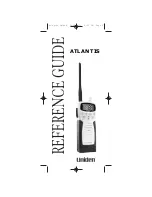
DNT500
2008 by RF Monolithics,
Inc.
1
M-0500-0000 Rev D
1. INTRODUCTION
The DNT500 series transceivers provide highly reliable wireless connectivity for either
point-to-point or point-to-multipoint applications. Frequency hopping spread spectrum
(FHSS) technology ensures maximum resistance to multipath fading and robustness in
the presence of interfering signals, while operation in the 900 MHz ISM band allows
license-free use in the US, Canada, Australia and New Zealand. The DNT500 supports
all standard serial data rates for host communications from 1.2 to 460.8 kb/s. On-board
data buffering and an error-correcting air protocol provide smooth data flow and sim-
plify the task of integration with existing applications. Key DNT500 features include:
-
Multipath fading impervious fre-
quency hopping technology with
up to 50 frequency channels
(902 to 928 MHz).
-
Supports point-to-point or multi-
point applications.
-
Meets FCC rules 15.247 for li-
cense-free operation.
-
20 mile plus range with omni-
directional antennas.
-
Transparent ARQ protocol with
buffering ensures data integrity.
-
Selectable 0, 10, 19, 24, 27 or
28 dBm transmit power with a
firmware interlock of 19 dBm maxi-
mum for 500 kb/s operation.
-
Built-in data scrambling reduces
possibility of eavesdropping.
-
Nonvolatile memory stores configu-
ration when powered off.
-
Dynamic TDMA slot assignment
that maximizes throughput.
-
Simple serial interface handles both
data and control at up to 460.8 kb/s.
1.1 Why Spread Spectrum?
A radio transmission channel can be very hostile, corrupted by noise, path loss and
interfering transmissions from other radios. Even in an interference-free environment,
radio performance faces serious degradation through a phenomenon known as multi-
path fading. Multipath fading results when two or more reflected rays of the transmit-
ted signal arrive at the receiving antenna with opposing phases, thereby partially or
completely canceling the signal. This is a problem particularly prevalent in indoor in-
stallations. In the frequency domain, a multipath fade can be described as a fre-
quency-selective notch that
shifts in location and intensity over time as reflections
change due to motion of the radio or objects within its range. At any given time, mul-
tipath fades will typically occupy 1% - 2% of the band. This means that from a prob-
abilistic viewpoint, a conventional radio system faces a 1% - 2% chance of signal im-
pairment at any given time due to multipath.
Spread spectrum reduces the vulnerability of a radio system to interference from both
jammers and multipath fading by distributing the transmitted signal over a larger re-
gion of the frequency band than would otherwise be necessary to send the informa-
tion. This allows the signal to be reconstructed even though part of it may be lost or
corrupted in transit.






































